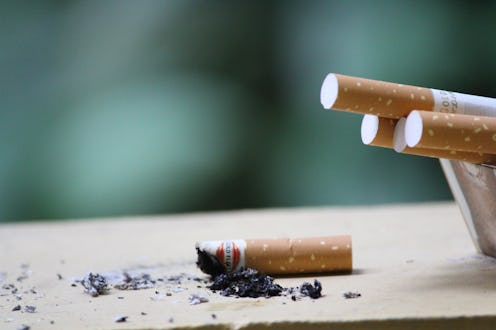Life
The Silent Dangers Of "Thirdhand Smoke"
The many health risks of first and secondhand smoke are well known, but research reveals that the danger doesn’t end there. Scientists are studying the risks of thirdhand smoke, the residue of tobacco smoke left behind on surfaces ranging from clothing to carpet. Recent studies link thirdhand smoke to low weight and changes in blood count, and suggest that this type of smoke exposure is especially dangerous to babies and children.
Secondhand smoke — smoke inhaled from another person’stobacco product — has killed 2.5 million adults since 1964, according to the CDC, but you don’t have to be with a person who is smoking to be exposed to the harmful chemicals found in tobacco. Anyone who has caught the pungent scent of a sofa that has been exposed to cigarette smoke knows that the smoke doesn’t simply disappear into the ether once it’s exhaled. It lingers on surfaces and fabrics, often for extended periods of time. That residue is thirdhand smoke, and it carries many of the same toxic chemicals as first and secondhand smoke.
A recent study by researchers from the Department of Energy's Lawrence Berkeley National Laboratory, UC San Francisco, and Nanjing Medical University looked into the effect of thirdhand smoke on adult and juvenile mice. After being exposed for three weeks to thirdhand smoke, newborn mice were found to weigh significantly less than newborn mice that had not had contract with smoke. Thirdhand smoke did not appear to have a similar effect on young adult mice. When the newborn mice's smoke exposure stopped, their weight went up, and eventually caught up with that of their peers.
The study, published in February in Scientific Reports, also found that exposure to thirdhand smoke impacted blood cell counts for both newborn and adult mice, particularly “white blood cells associated with inflammation and allergic reactions,” according to a press release. These affects stuck around long after the exposure to smoke ended.
The researchers believe children and infants to be especially at risk from thirdhand smoke, for a number of reasons. “Babies and children are maybe even more sensitive than adults, as they spend more time on the contaminated floor, have frequent hand-to-mouth actions, more skin contact with surfaces, and breathe in more dust-contaminated air than adults, in relation to their body size,” lead study author Bo Hang told Café Mom. “Children may also be more susceptible to the harm of thirdhand smoke as they may metabolize chemicals differently than adults, and are rapidly developing.”
A study published this year in Tobacco Control would seem to support this theory. It found that children taken to the hospital for respiratory problems linked to exposure to secondhand smoke had significantly higher levels of nicotine on their hands than adults exposed to secondhand smoke. The researchers suggested that these higher levels of nicotine could be evidence of children's heightened thirdhand smoke exposure.
The Scientific Reports study did not assess how thirdhand smoke might lead to specific diseases and health conditions in humans, but it does show that thirdhand smoke can have a powerful effect on both infant and adult animals and suggests that people should be careful of exposing others — especially babies and children — to surfaces that have been subjected to tobacco smoke.
To prevent infants’ exposure to thirdhand smoke, CaféMom urges people not to smoke indoors, to clean exposed surfaces thoroughly, and vacuum using a HEPA filter. Before holding infants or children, smokers should shower and change into smoke-free clothing.
